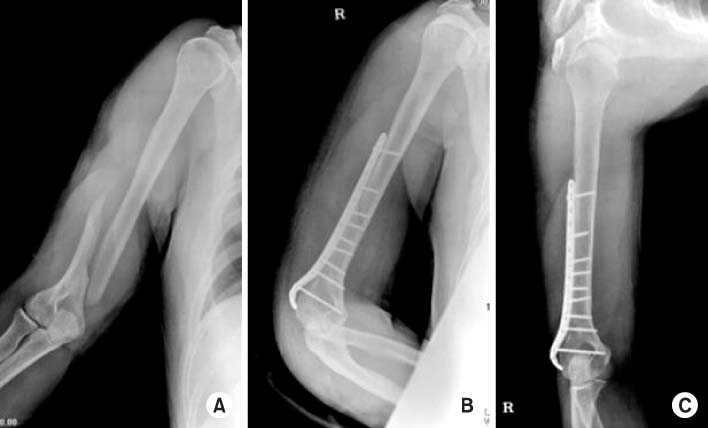J Korean Fract Soc.
2008 Oct;21(4):292-296. 10.12671/jkfs.2008.21.4.292.
Contributing Factors of Radial Nerve Palsy Associated with Humeral Shaft Fracture
- Affiliations
-
- 1Department of Orthopaedic Surgery, Guri Hospital, Hanyang University College of Medicine, Guri, Korea. kcpark@hanyang.ac.kr
- 2Department of Orthopaedic Surgery, Hanyang University College of Medicine, Seoul, Korea.
- KMID: 1480918
- DOI: http://doi.org/10.12671/jkfs.2008.21.4.292
Abstract
-
PURPOSE: To analyze related factors of radial nerve palsy in patients with humeral shaft fractures.
MATERIALS AND METHODS
We reviewed 107 paients with humeral shaft fracture between January 2000 and June 2007. Thirteen patients had radial nerve palsy after trauma and 9 patients after the operation. We analyzed contributing factors of radial nerve palsy associated with humeral shaft fracture including the cause of trauma, location and pattern of fracture, surgical approach and tourniquet application in cases of plate fixation, the exploration for the nerve and the time for operation.
RESULTS
The difference in the incidences of radial nerve palsy after trauma and operation was not significant according to the location and pattern of fracture. The tendency of higher rate of radial nerve palsy after trauma in oblique or comminuted fractures, and after operation in spiral fractures was observed. The operation using intramedullary nailing and radial nerve exploration significantly reduced the incidence of radial nerve palsy after operation (p=0.01 and p=0.02). Posterior approach in open reduction and plate fixation showed a tendency of lower incidence of radial nerve palsy after operation (p=0.78). In logistic regression analysis, radial nerve exploration was the only significant factor that reduced the possibility of radial nerve palsy after operation (17.27: odds ratio, p=0.02).
CONCLUSION
In humeral shaft fractures, we should take into consideration whether intramedullary nailing is possible or not. In cases of anterior or anterolateral approach of open reduction and plate fixation, radial nerve should be carefully inspected. In most cases, we recommend radial nerve exploration in order to minimize the possibility of radial nerve palsy after operation.
Keyword
MeSH Terms
Figure
Cited by 3 articles
-
Treatment of Radial Nerve Palsy Associated with Humeral Shaft Fracture
Soo-Hong Han, Jin-Woo Cho, Han-Seung Ryu
Arch Hand Microsurg. 2020;25(1):60-66. doi: 10.12790/ahm.19.0071.Polarus Intramedullary Nail for Proximal Humeral and Humeral Shaft Fractures in Elderly Patients with Osteoporosis
Youn-Soo Hwang, Kwang-Yeol Kim, Hyung-Chun Kim, Su-Han Ahn, Dong-Eun Lee
J Korean Fract Soc. 2013;26(1):14-20. doi: 10.12671/jkfs.2013.26.1.14.Associated Factors of Radial Nerve Palsy Combined with Humerus Shaft Fracture
Si-Wuk Lee, Chul-Hyun Cho, Ki-Choer Bae
J Korean Fract Soc. 2014;27(3):185-190. doi: 10.12671/jkfs.2014.27.3.185.
Reference
-
1. Blum J, Rommens PM. Surgical approaches to the humeral shaft. Acta Chir Belg. 1997; 97:237–243.2. Duncan DM, Johnson KA, Monkman GR. Fracture of the humerus and radial nerve palsy. Minn Med. 1974; 57:659–662.3. Garcia A Jr, Maeck BH. Radial nerve injuries in fractures of the shaft of the humerus. Am J Surg. 1960; 99:625–627.
Article4. Holstein A, Lewis GM. Fractures of the humerus with radial-nerve paralysis. J Bone Joint Surg Am. 1963; 45:1382–1388.
Article5. Kesemenli CC, Subasi M, Arslan H, Necmioglu S, Kapukaya A. Comparison between the results of intramedullary nailing and compression plate fixation in the treatment of humerus fractures. Acta Orthop Traumatol Turc. 2003; 37:120–125.6. Kettelkamp DB, Alexander H. Clinical review of radial nerve injury. J Trauma. 1967; 7:424–432.
Article7. Kim DH, Shin KC, Kim KS, Lee SH. Ender nailing of humeral shaft fractures. J Korean Soc Fract. 1997; 10:614–620.
Article8. Klenerman L. Fractures of the shaft of the humerus. J Bone Joint Surg Br. 1966; 48-B:105–111.
Article9. Ko SM, Kim MG, Kim RS, Oh IS, Lee JY, Jeong HC. Treatment of humerus fracture using ilizarov external fixator. J Korean Soc Fract. 2000; 13:30–37.
Article10. Lin J. Treatment of humeral shaft fractures with humeral locked nail and comparison with plate fixation. J Trauma. 1998; 44:859–864.
Article11. Pollock FH, Drake D, Bovill EG, Day L, Trafton PG. Treatment of radial neuropathy associated with fractures of the humerus. J Bone and Joint Surg Am. 1981; 63:239–243.
Article12. Shah JJ, Bhatti NA. Radial nerve paralysis associated with fractures of the humerus. A review of 62 cases. Clin Orthop Relat Res. 1983; 172:171–176.13. Shao YC, Harwood P, Grotz MR, Limb D, Giannoudis PV. Radial nerve palsy associated with fractures of the shaft of the humerus: a systemic review. J Bone Joint Surg Br. 2005; 87:1647–1652.14. Shaw JL, Sakellarides H. Radial-nerve paralysis associated with fractures of the humerus. A review of forty-five cases. J Bone Joint Surg Am. 1967; 49:899–902.
- Full Text Links
- Actions
-
Cited
- CITED
-
- Close
- Share
- Similar articles
-
- Treatment of Radial Nerve Palsy Associated with Humeral Shaft Fracture
- Surgical Treatment of Old Radial Nerve Palsy Associated with Nonunion of Humeral Shaft Fractures
- A Clinical Study of the Humeral shaft Fracture
- Associated Factors of Radial Nerve Palsy Combined with Humerus Shaft Fracture
- Internal Fixation of Humeral Shaft Fractures Using Anterior Plating Technique


